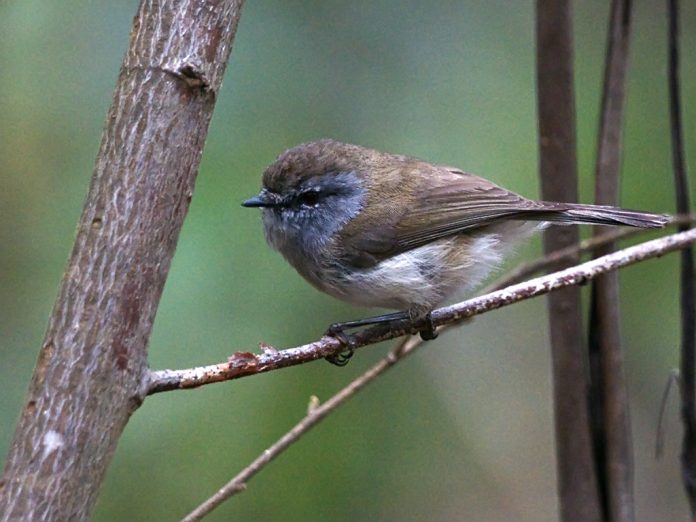Like other Australian warblers, the Brown Gerygone (Gerygone mouki) builds its nest in three stages. First, it makes a hanging, solidly interwoven mass of fiber bound with cobweb, gradually building it up to become longer and thicker. Then it makes a hole in the side, usually towards the top, which it hollows out and enlarges by shuffling and turning in the cavity; in the process, it pushes out the walls of the nest. Lastly, it covers the entrance hole all around.
The ultimate shape of the nest depends very much on the time spent in each of these stages. It is usually about 250–300 mm long, including the 70–120 mm ‘tail’. The unobtrusive yet incessant twittering of the Brown Gerygone is among the characteristic sounds of the rainforests of eastern Australia.
The bird is abundant in these forests, where it lives year-round. Singly, in pairs, or in loose three or four out of breeding, it feeds quietly but energetically through the inner and outer foliage of the trees, at two to 20 meters above the ground. The birds frequently join foraging groups of other species to wander. It is also known as Northern Warbler, Brown Fly Eater, Citron Bird, and Brown Warbler. The size of the bird is 90–110 mm.
Both sexes are alike. Upperparts rich, deep olive-brown, often toned rusty, with a distinct white stripe on side of forehead extending back towards but hardly over eye; indistinct white eye-ring, dark lores; cheeks grey, finely scalloped with white. The wings are back, and the flight feathers are grayer-brown.
The tail is gray-brown, with a broad black bar near the tip and a distinct white spot at the inner tip of all tail feathers except the central pair. Underparts cream to soft grey on throat, neck, and breast, with or without red-brown wash on sides of the belly.
The eyes are rich red-brown with a black bill. However, the feet are deep olive-gray to black. The immature (as adults) have brown eyes. Brown Gerygone calls consist of three-to-five-syllable soft Twitter, diddle-it-did-dit, around the same pitch, repeated rapidly and incessantly throughout the day, even when not breeding.
The nesting and breeding seasons occur from September until February. Nest build is a slender dome with a long bulky tail and projecting side-entrance hood extended into a funnel of soft-bark fiber and rootlets through the thick growth fringing the rainforests.
Like all Australian gerygones, the Brown gleans its insect food from leaves and branches but occasionally darts out like a flycatcher to capture insects on the wing or takes them in flight while hovering with rapid wing beats about the outer foliage. While feeding, it has a tendency to shake its wings and flick its tail.
Both sexes call while breeding, but the males twitter more loudly and insistently, often perching close to where the female is constructing the nest. This call seems to maintain contact and announce territory, though it does not seem to have become as specialized for the latter purpose as in other Australian gerygones.

Brown Gerygones, from coastal New South Wales to northeastern Queensland, lack the sweet, sibilant song of the others. They also differ in that the display between the sexes is more mutual. The birds bow slightly and delicately and fan their tails to reveal white spots at the tips.
Only the female incubates, but both sexes—and sometimes additional helpers—feed the young. grass and moss bound firmly with cobwebs, adorned with lichen or green moss; lined with soft plant down or, rarely, fur or feathers; slung from a slender stem among hanging branchlets or lawyer-vines in rainforests 1–15 meters above ground, often near water.
Eggs: two or three; matt white to pink, freckled, spotted, and blotched with dull to bright red and purple-red, often in a zone at the larger end; oval, about 17 x 12 mm. Incubation: 16–19 days, apparently by a female. Young fledge in about 15–16 days.
The bird is found in cool, subtropical rainforests and their fringes in eastern coastal Australia and adjacent ranges to about 1200 m high, from Cook Town, Queensland, south to Gippsland, Victoria, and inland to the Carnarvon Range.
Also Read: Torresian Crow Call
